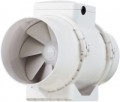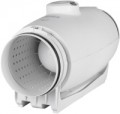Type
—
Domestic extraction. Domestic fans are capable of operating only for extraction — for blowing air out of the room. Such units have relatively low power and are used in small rooms — bathrooms, kitchens, workshops, etc. And the overhead installation method assumes that the device is partially or completely located outside the ventilation duct. The specific features of the installation can vary from devices almost completely hidden in the ventilation (with only a cover protruding) to completely outdoor units connected to the duct with a separate pipe.
— Domestic supply and extraction. Also, such models are known as
window fans, since they are most often installed precisely in windows or wall openings (and not in ventilation ducts, unlike the extraction models described above). As the name implies, fans of this type can operate both in extract and inflow and are intended mainly for domestic use — in residential premises and other places where high performance is not required.
—
Inline. In a broad sense, inline fans are called fans installed deep in the ventilation ducts and completely hidden inside. However, in this case, only one type of such unit is meant — models that work in one direction (extraction); “two-way” devices are placed in a separate category, see below about them. Anyway, inline fans can serve several ventilation outlets at once, which m
...akes them well-suited for centralized systems.
— Inline (for recuperation). A kind of duct fan (see above), capable of operating in two directions — both for extraction and supply, switching between them at the user's command. It is these units that are optimally suited for use in centralized ventilation systems with heat exchangers, although they can also be used without heat exchangers.
— Wall mounted. Wall fans that work only in one direction — extraction. Outwardly, such devices resemble domestic extraction fans(see above), but this similarity is rather deceptive. Firstly, the case in wall-mounted units is usually flat, at the same time, during installation, it is located mainly outside, and the installation depth is quite small. Secondly, fans of this type have a purely utilitarian purpose, and they are not characterized by designer gimmicks. Thirdly, such devices are quite powerful and performant: relatively modest wall-mounted fans are comparable in performance to the most solid domestic extraction models.
— Wall-mounted (for recuperation). A kind of wall fan (see above), capable of operating in two directions — both for extraction and supply, switching between them at the user's command. It allows such models to be used in combination with heat exchangers, although the heat exchanger itself is not required for fan operation.Mounting diameter
Mounting diameter refers to the size of the space required for the normal installation of the fan. Some manufacturers indicate in this paragraph which standard pipe the unit is designed for (for example,
100 mm or
125 mm), others give the dimensions of the body or extraction pipe (for wall models) — that is, the part placed directly into the duct. Anyway, knowing the mounting diameter, you can evaluate how the fan fits the intended installation site.
Type of bearing
The type of bearing installed in the fan.
The bearing is a part that secures the rotating part of the fan to the stationary part and reduces friction between these parts. By type, it can be as follows:
— Plain bearing. The action of such bearings is based on the friction between two conjugated, that is, directly pressed one to the other over the entire area, surfaces. However, these surfaces are in contact with each other relatively weakly — between them is a layer of lubricant that reduces friction. In addition, to reduce resistance, rubbing parts are usually carefully polished and made of anti-friction materials. The main advantage of plain bearings is the simplicity of design and the resulting low cost. However, such parts are less durable than ball bearings, and they create more noise.
— Ball bearing. The principle of operation of a ball bearing is that a set of balls is placed between its movable and stationary parts, which roll inside during movement. Compared to plain bearings, such bearings last much longer, and they create less noise during operation. On the other hand, fans with similar equipment are noticeably more expensive.
Air flow (extraction)
This parameter describes the amount of air that the fan can pass through itself per hour when operating in extraction mode (see "Type"). It is one of the key characteristics of any extractor fan — it characterizes the overall performance and suitability of the unit for a particular room.
When choosing a fan for
maximum performance, two main indicators must be taken into account — the volume of the room and the air flow rate. The volume can be found by multiplying the area of the room by the height of the ceilings: for example, for a room of 12 m² in a residential apartment with standard ceilings of 2.5 m, this figure will be 12x2.5=30 m³. The air flow rate describes how many times per hour the air in an enclosed space must be completely replaced for ventilation to be sufficiently effective. This multiplicity is different for different types of premises: in particular, for the kitchen, it is 6-8, for the bathroom — 8-10, etc. More detailed values be found in specialized sources, in particular, sanitary standards. And the minimum required fan performance is calculated by multiplying the air volume by the air exchange rate. For example, if we have a bathroom with an area of 4 m² with the same ceiling of 2.5 m, then the volume of air in it will be 4x2=10 m³; Considering that the minimum air exchange rate for bathrooms is 7, for this room we need a fan with a capacity of at least 70 m³/h.
Air flow (intake)
The amount of air that the fan can pass through itself when operating in the supply mode (see "Type — Domestic supply and exhaust"). The value of this parameter is completely similar to the performance in the extraction mode; see above for more details.
Rotational speed
The nominal fan speed during operation.
The rotational speed is one of the factors affecting the performance and, consequently, the overall efficiency of the fan. At the same time, this factor is far from being the only one. A lot also depends on the design of the blades, their number, the diameter of the impeller, etc. Therefore, fans with the same speed can differ significantly in capabilities, and you should pay attention primarily to performance.
At the same time, the rotation speed still has a certain practical significance. On the one hand, faster fans produce more noise; this drawback can be compensated to a certain extent by design tricks, but they, in turn, noticeably affect the price. On the other hand, to ensure the desired level of performance, lower-speed fans must either have impellers of a larger diameter (which accordingly affects the dimensions, and in most cases, the installation size) or, again, use design tweaks that affect the price.
Power consumption
The power consumed by the fan during normal operation.
This parameter primarily affects the power consumption of the device and the load on the power grid created during its operation. However, the latter is usually not critical, since the power of most modern fans is low. Also, the more powerful the device, the higher its performance(see above). However, there is no unambiguous dependence here — much is determined by how effective the design is. Therefore, models with the same performance can differ markedly in power consumption.
When choosing between two similar models with different power consumption, you should proceed with how often and for how long you plan to turn on the fan. If regular work is expected for a long time — for example, to ventilate the kitchen while cooking — you should pay attention to a less powerful model. It may cost more, but the price difference can quickly pay off in energy savings. If the fan turns on occasionally (for example, when installed in the bathroom of a residential apartment), you can not pay much attention to the power consumption.
Remote control
Abillity of work of the fan with the
remote control; the remote itself is usually supplied with the device.
This feature greatly simplifies the control of the unit: you can give commands from anywhere within the range of the remote control, and you do not have to go to the fan (or external switch) every time. It is especially useful when the fan is installed in a hard-to-reach place. The mentioned limits of operation are limited by the fact that the infrared channel is usually used for control — which means that the remote control must be in the same room with the fan (more precisely, the signal receivers on the fan) and there should be no obstacles between them. However, even this is sufficient in most cases.
Also, it is very convenient to transfer control of additional functions to remote controls — timers, enable/disable sensors, etc. (see above). Therefore, in some fans, these functions are implemented exclusively through the remote control.
Noise level
The noise level reproduced by the fan in normal operation.
The
lower the noise level, the more comfortable the use of the fan will be, the better it is suitable for rooms in which it is desirable to keep silence. In addition, there are certain regulations written in sanitary standards (for example, for residential premises during the day, a constant noise level of up to 40 dB is considered acceptable, and at night — up to 30 dB).
When choosing according to specific values recorded in the characteristics, it should be taken into account that the decibel used to measure the noise level is not a linear quantity: for example, an increase in sound power by 2 times corresponds to an increase of 3 dB, 10 times — by 10 dB, 100 times — by 20 dB. Therefore, to assess the noise level, it is easiest to refer to comparative tables, where the correspondence of specific values in decibels to various real sound sources is recorded. In most modern fans, noise is between 20 and 60 dB, here is the simplest table for this range:
20 – 25 dB — a weak audible sound, comparable to a whisper at a distance of 1 – 2 m;
25 – 30 dB — intelligible whisper at a short distance, ticking of a wall clock;
35 dB — muffled conversation;
40 – 45 dB — normal human speech;
50 – 55 dB — talking in raised tones, noise in the office;
60 dB — loud conversation at a distance of several metres.
Note that patter
...ns over 50 dB are rare; usually, these are “industrial” class units with a 400 V power supply and a large mounting diameter (see above), not intended for residential premises.
